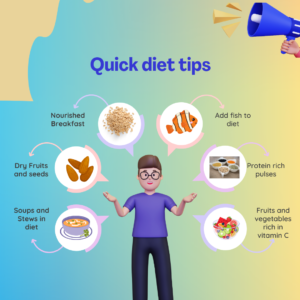Winter is a season that demands careful attention to our dietary choices, as our nutritional needs and energy requirements undergo shifts in response to the colder temperatures. Maintaining a well-balanced diet during this time becomes essential for sustaining overall health and vitality. In this context, it becomes imperative to explore the key components of a winter diet that contribute to keeping our bodies nourished and resilient in the face of seasonal challenges.
Perfect start of the always starts with a delicious and nourished breakfast. Few options to consider when it comes to breakfast could be a steaming bowl of oatmeal adorned with seasonal fruits such as apples, pears, or berries provides a delightful combination of fiber and vitamins. Alternatively, a comforting bowl of hot cereal like cream of wheat or farina can be a soothing choice. For those seeking a protein-packed start, scrambled eggs with spinach or a fluffy omelet filled with mushrooms and cheese offer a satisfying and nutritious meal. Pairing these dishes with a cup of piping hot herbal tea, spiced chai, or a rich mug of cocoa completes the winter breakfast experience, ensuring both warmth and sustenance for the day ahead. Incorporating these delicious and nutritious options into the winter morning routine can make breakfast a delightful ritual even in the coldest of days.
During the winter months, incorporating fish into your diet is a wise choice for both flavor and health. Fatty fish like salmon and mackerel, rich in omega-3 fatty acids and vitamin D, can be particularly beneficial when sunlight exposure is limited. Whether grilled, baked, or in a hearty stew, fish adds a delicious and nutritious element to winter meals. Its lean protein content supports muscle health, making it a versatile and wholesome addition to your winter culinary repertoire. So, consider savoring a grilled fillet or enjoying a comforting fish stew to not only warm your taste buds but also nourish your body during the colder seasons.
 Embrace winter’s goodness by sprinkling your diet with a handful of nature’s treasures – dry fruits and seeds. Nuts like almonds and walnuts, dancing with healthy fats, join the fruity melody of apricots and raisins. Seeds like chia and flax add a crunchy beat, delivering omega-3s and protein. Mix them into your morning yogurt or toss them into salads for a burst of flavor and nutrition. A winter trail mix becomes your pocket-sized powerhouse, fueling you through chilly days and adding a dash of creativity to your plate.
Embrace winter’s goodness by sprinkling your diet with a handful of nature’s treasures – dry fruits and seeds. Nuts like almonds and walnuts, dancing with healthy fats, join the fruity melody of apricots and raisins. Seeds like chia and flax add a crunchy beat, delivering omega-3s and protein. Mix them into your morning yogurt or toss them into salads for a burst of flavor and nutrition. A winter trail mix becomes your pocket-sized powerhouse, fueling you through chilly days and adding a dash of creativity to your plate.
Incorporating protein-rich pulses into your diet is a smart and nutritious way to boost your protein intake, especially for those following a vegetarian or plant-based lifestyle. Lentils, chickpeas, black beans, and split peas are excellent sources of protein, offering a wide array of essential amino acids crucial for various bodily functions. These pulses are not only rich in protein but also provide fiber, vitamins, and minerals, contributing to overall health. Consider incorporating lentils into hearty soups or stews, chickpeas in salads or as a base for hummus, black beans in burritos or wraps, and split peas in comforting dals. These versatile pulses not only enhance the flavor and texture of your meals but also offer a sustainable and plant-powered protein source. Including a variety of protein-rich pulses in your diet ensures a well-rounded and nourishing approach to meeting your dietary protein needs.
 Opting for fruits and vegetables rich in vitamin C is an excellent way to support your immune system and promote overall health. Citrus fruits such as oranges, grapefruits, lemons, and limes are classic choices, bursting with vitamin C. Berries like strawberries, blueberries, and raspberries also provide a healthy dose of this essential nutrient.
Opting for fruits and vegetables rich in vitamin C is an excellent way to support your immune system and promote overall health. Citrus fruits such as oranges, grapefruits, lemons, and limes are classic choices, bursting with vitamin C. Berries like strawberries, blueberries, and raspberries also provide a healthy dose of this essential nutrient.
Among vegetables, bell peppers, particularly the red and yellow varieties, are notable sources of vitamin C. Broccoli, Brussels sprouts, kiwi, papaya, and tomatoes are also excellent choices. Including a colorful array of these fruits and vegetables in your diet not only adds vibrant flavors but also ensures you get a good supply of vitamin C, which plays a key role in collagen formation, iron absorption, and immune system function.
Winter beckons the warmth of soups and stews, transforming meals into comforting rituals. As temperatures drop, there’s nothing quite like wrapping your hands around a steaming bowl filled with goodness. From the classic allure of chicken noodle soup to the robust charm of vegetable stews, these dishes offer both solace and nourishment. Laden with seasonal vegetables, proteins, and aromatic herbs, soups and stews become a canvas for culinary creativity, adapting to diverse tastes and preferences. The slow, deliberate simmering not only melds flavors but also releases a fragrant aroma that fills the kitchen, inviting all to gather around the table. Whether it’s the chunkiness of minestrone, the warmth of spicy chili, or the velvety texture of butternut squash soup, these winter staples provide a delicious symphony for the senses, a perfect way to savor the season’s offerings and keep the cold at bay.
To summarize, Winter demands a mindful approach to nutrition, adapting to colder temperatures. A nourishing breakfast sets the tone, with options like oatmeal or protein-packed eggs. Fish, especially fatty varieties like salmon, becomes a flavorful and healthy addition, addressing vitamin D needs. Diversify your diet with dry fruits and seeds for a nutrient-rich boost, creating a winter trail mix. Protein-rich pulses like lentils and chickpeas offer a plant-based protein source, ideal for varied dishes. Boost your immune system with vitamin C from citrus fruits, berries, and vegetables. Finally, embrace the warmth of soups and stews, from classic chicken noodle to vegetable variations, creating a comforting symphony for the senses during the chilly season.









